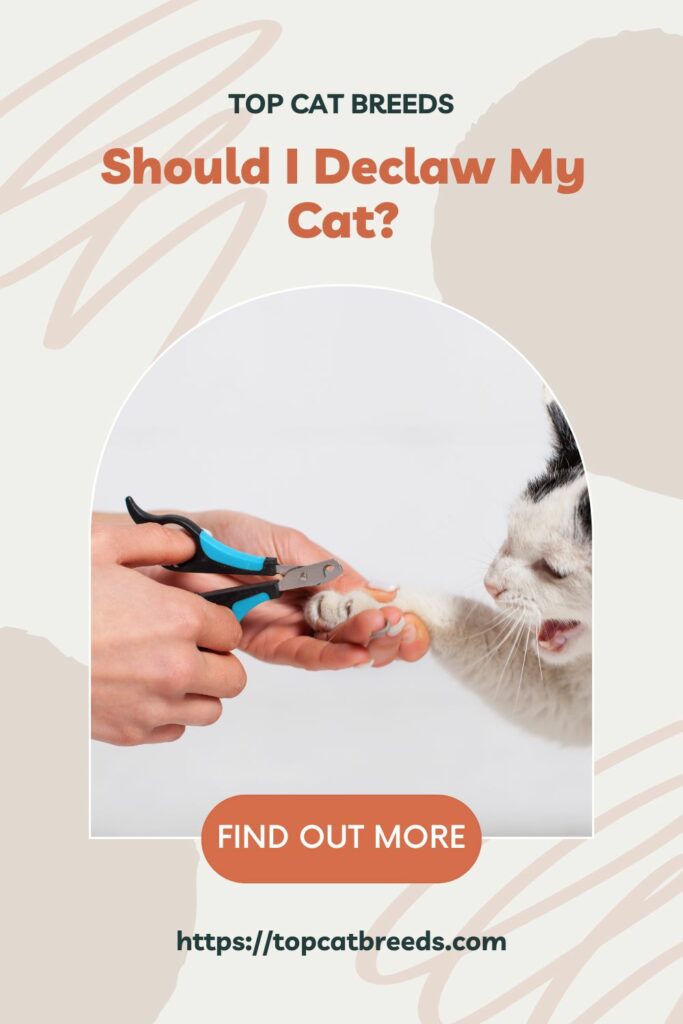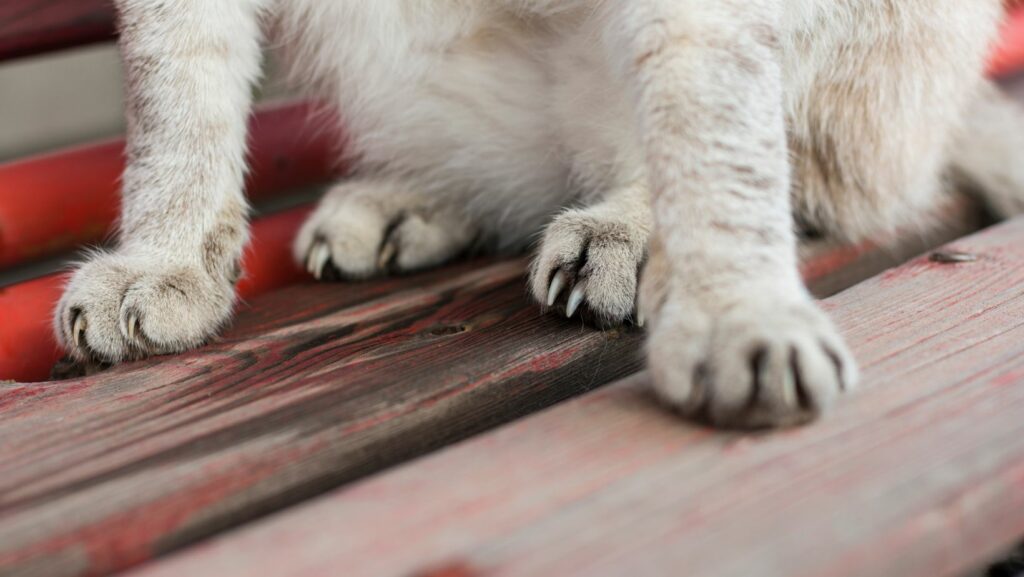Should I declaw my cat? Declawing cats has become a controversial and hotly debated topic in recent years. Animal welfare organizations have come out strongly against the practice, citing the potential long-term consequences that it may have on cats.
In this article, you will decipher the pros and cons of declawing cats and what owners should consider when deciding whether or not to declaw their pets. We will also look at alternatives to declawing and advise how to best care for cats with intact claws
.

Should I Declaw My Cat?
Deciding whether to declaw your cat is a difficult decision. While declawing can provide a solution to damaged furniture, it is also a major surgical procedure that can cause pain and distress for your cat.
Furthermore, declawing can lead to other health problems, such as infection, behavior problems, and long-term joint pain. Therefore, it is essential to consider the risks and benefits of declawing before making the decision.
If you decide that declawing is the best for your cat, make sure you find a qualified vet to do the procedure. Proper aftercare is also essential for your cat’s recovery. Sometimes, your vet may recommend alternatives such as nail caps or frequent nail trims instead of declawing. Ultimately, it is vital to research and consider all your options before deciding to declaw your cat.
Pros of Declawing Cats
Here are the advantages of declawing your cats at home:
Reduced Risk Of Injury To Humans
Declawing cats can reduce the risk of injury to humans. Cats are naturally curious and playful animals, but their claws can cause serious harm to humans. When cats scratch, they can break the skin and cause infections. By declawing cats, humans are no longer at risk of being injured by their claws.
Additionally, a declawed cat is less likely to scratch furniture or other items, reducing the risk of injury to people who come in contact with the furniture.
Reduced Risk Of Furniture Damage
Declawing cats can reduce the risk of furniture damage, as cats can often use their claws to scratch furniture. With declawed cats, you will not have to worry about this risk, as cats cannot scratch furniture and cause damage. It means that furniture will last longer and demand less maintenance and repairs.
Additionally, it can help keep the cats away from furniture that may be off-limits to them, as they cannot scratch and claw it.
Read also: 3 Important Tips on How to Protect Leather Couch from Cats
Reduce Instances Of Inappropriate Scratching
Declawing cats can help reduce instances of inappropriate scratching. Cats naturally scratch to shed their old claws and to mark their territory. You can eliminate this behavior by declawing cats and lowering instances of cats scratching furniture, walls, and other objects inside the home.
Additionally, declawing cats can help reduce their instinct to scratch, making them more amenable to other forms of training, such as scratching posts and other scratching alternatives. Furthermore, declawing cats can help to keep them from scratching people, reducing the risk of injury or the spread of disease.
Read also: What To Do If Your Cat Scratches You? 7 Tips to Stop the Behavior
Cons of Declawing Cats
On the other hand, below are the drawbacks of declawing felines:
Declawing Is An Invasive And Painful Procedure
It involves the amputation of a cat’s claws and the end bones of its toes. Vets use a scalpel, a laser, or an electrical cauterizing device for convenience rather than medical necessity.
As a result, the procedure can cause extreme pain and discomfort for the cat and can lead to permanent damage to its paws. Not only is the process itself painful, but it can also be traumatizing for the cat and cause long-term anxiety and stress.
Furthermore, declawing cats can lead to an increased risk of urine spraying and can also cause them to walk abnormally or develop behavioral problems.
Declawing Links To Behavioral Issues In Cats
Declawing cats is famous for affecting behavioral issues in cats, such as increased aggression, biting, and inappropriate urination. The amputation of a cat’s claws can be a traumatic experience and lead to long-term physical and psychological damage.
Declawed cats may develop chronic pain and discomfort and experience difficulty walking or balancing. Furthermore, declawed cats may be more likely to bite or scratch, as they no longer have claws to defend themselves. It will help if you consider various factors before declawing cats.
Declawing Can Have Long-term Health Implications For Cats
In declawing, cats suffer trauma to their paws, leading to nerve damage, chronic pain, and inflammation. It can cause cats to have difficulty walking and can lead to arthritis.
Declawing can cause cats to develop stress-related behavioral issues, such as aggression, excessive grooming, and excessive vocalization. In addition, cats with no nails may be unable to defend themselves adequately against predators, making them more likely to become victims of animal attacks.
Alternatives to Declawing

There is a continuous debate about the pros and cons of declawing cats. But, there is no single response to the question “Should I declaw my cat?” because every cat is different, and their pain tolerance or nail growth is also different. Instead of declawing cats that might cause their body trauma, you can apply these alternatives:
Trimming Nails
Trimming nails is a much more humane alternative to declawing. When you or a vet trim your furry friend’s nails properly, it will not cause pain or discomfort. You can do this in your home or with a professional groomer.
It is essential to do this regularly, as long nails can lead to discomfort and other problems. Additionally, owners should consider investing in a scratching post or other toys as an alternative for cats to scratch on rather than furniture.
Read also: The Best Way to Trim Cat Nails Safely
Providing Scratching Posts
Providing scratching posts is an excellent alternative to declawing cats. Giving the cats a designated area to scratch is essential to help them exercise, stretch, and mark their territory. Scratching posts should be tall enough to allow cats to test thoroughly and should be made of materials that cats enjoy scratching.
You can also use catnip or other scented materials on the posts to encourage cats to use them. Additionally, it is crucial to ensure cats have access to multiple scratching posts in different home locations, so they do not feel confined to one area.
Applying Nail Caps
Nail caps are soft, plastic, claw-shaped covers applied to the cat’s claws. These caps blunt the claws so they can’t cause damage while allowing the cat to scratch and climb. The caps are applied with a unique adhesive and must replace every 4-6 weeks.
While this method can be time-consuming, it is a humane alternative to declawing, and any cat owner should consider this if they want to protect their furniture and skin from scratches.
Conclusion
In conclusion, it is essential to weigh the pros and cons of declawing your kitten before making a decision. The procedure is not without risks and is not without ethical implications. It is essential to consider the possible defects of the process, such as pain and the possibility of behavioral changes, before ultimately making the decision.
Ultimately, declawing should be only necessary for the health and safety of your cat and your family. If you are considering declawing your cat, it is essential to consult a veterinarian to discuss all the risks and benefits of the procedure.

